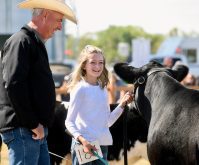It’s just a trickle now, but there are fears of a flood of cattle going to market if the drought continues.
“It’s a little too early to be splitting up pairs, but we are seeing some pairs sell,” said Anne Wasko, market analyst with Gateway Livestock Services.
Sale figures are being closely watched these days to see if Alberta shrinks its herd just as American ranchers did during the 2012 drought in U.S. cattle country.
One Calgary auction mart, TEAM Auction Sales, sold almost 16,000 head in June, double last year’s level, according to CANFAX.
Read Also

Body condition, nutrition and vaccination for brood cows
One of the remarkable events of the past century related to ranching has been the genetic evolution of brood cows….
And yearlings that are normally on grass and sold in November are coming to market now, because there’s nothing for them to eat, said Barry Yaremcio, beef and forage specialist with Alberta Agriculture and Forestry.
More cow-calf pairs than previous years are showing up at auction marts in Lethbridge, Medicine Hat, Veteran, Stettler and Westlock — although it’s not known how many are bound for feedlots and how many to ranches that still have a supply of grass.
The real picture will emerge when Statistics Canada releases its Dec. 31 cattle numbers.
- From the Alberta Farmer: Sell or hang on? Cattle producers facing tough choices
“The guys are planning,” said Yaremcio. “They’re wondering if they have enough feed to make it through the winter, and if they want to pay the going price for hay.”
To make matters worse, some counties — such as Barrhead, Westlock and St. Paul — have been besieged by grasshoppers.
“Grasshoppers are looking for moisture and the easiest way for them to get moisture is to eat grass and forages,” said Yaremcio. “They’re in direct competition with the cow.”
Hay prices are up “as you would expect in these conditions,” said Wasko.
“As prices go up on the feed side, we’re still looking at record prices on the cattle side,” she said. “That’s part of the positive side of this crazy environment we’re in today. We’ve got record prices, but that might need to go onto the feed bill at the end of the day. It’s a different way of thinking. We’re going to have to pay more for feed, no question about it.”
“With (cattle) prices the way they are, people would like to hang on to as many animals as they can,” added Karin Schmid, beef production specialist with Alberta Beef Producers. “But it might not be an option if they don’t have enough feed for them.”
She recommends producers early wean or creep feed calves to try to avoid selling off too many cows.
Producers worried about their cows’ condition should consider putting out grain to help them maintain their body weight and provide them with energy, said Yaremcio.
“If they eat five pounds of barley or oats on pasture, that will replace 25 pounds of grass that they will eat on a daily basis,” he said.
Alexis Kienlen is a reporter with the Alberta Farmer Express

















